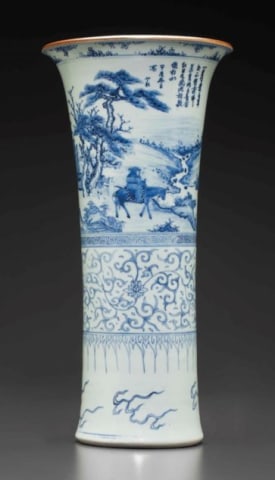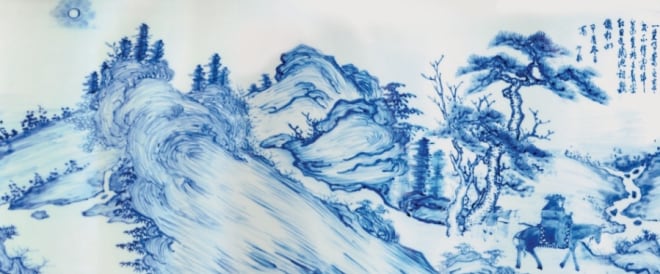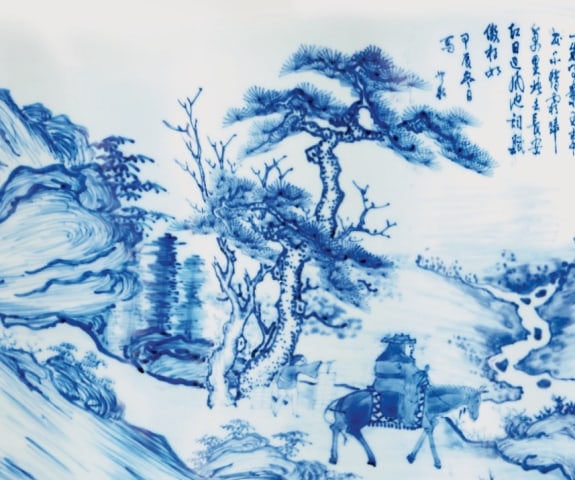A RARE BLUE AND WHITE DATED GU-FORM VASE, EARLY KANGXI PERIOD, DATED 1664
Height: 40cm; 15 ¾ in.
Further images
The tall cylindrical vase flares toward the mouth and is decorated on the upper register in a penciled style with a scene of a lone scholar on horseback in a...
The tall cylindrical vase flares toward the mouth and is decorated on the upper register in a penciled style with a scene of a lone scholar on horseback in a winter landscape, followed by an attendant carrying his books with a long inscription above. The scene is set between a border of dots at the rim and wide bands of lotus scroll and flames in the lower registers. The rim is dressed in brown and the flat base is unglazed.
Provenance
Collection of Julia and John Curtis, purchased from Anita Gray, 1998. Sold Christies, New York 'An Era of Inspiration: 17th-Century Chinese Porcelains from the Collection of Julia and John Curtis; (March 2015).Literature
The poetic inscription on this vase can be translated as:'My life's greatest enterprises rely on the five carts of books I have read. I do not mind traveling ten-thousand miles of frosty road to my destination, the capital city, where the red sun rises, and where, by the Phoenix Pond, my prose will match that of Sima Ziangru´.
Qianshen Bai discusses this vase in his article 'Inscriptions, Calligraphy, and Seals on Jingdezhen Porcelains from the Shunzhi Era' in Michael Butler, Julia B. Curtis and Stephen Little, Shunzhi Porcelain: Treasures from an Unknown Reign, 1644-1661, Alexandria, VA, 2002, pp. 56-67, where he notes the difficulty of transferring calligraphy from a poem onto porcelain. He explains that the physical difficulty of writing on a curving surface was compounded by most porcelain painters' lack of knowledge of literature and writing. While the poem on this vase is beautifully conceived in the overall decorative scheme of the scene, the inscription does in fact include a few mistakes. Qianshen Bai notes, "…This poem is about a scholar on his way to the capital to take the metropolitan civil service examination. If he passed, he would then take the palace examination held by the emperor. The 'Phoenix Pond' refers to a pond in the imperial garden. The poet's use of the first person tells us that he was confident of his success, believing that his writing would win him a jinshi, the highest, degree and a government post. Ironically, although the poem concerns a scholar's confidence in succeeding in the imperial examinations because of his fine writing, its transcription includes several mistakes." (p. 66) These minor mistakes in the transfer of the calligraphy to porcelain, however, can easily be forgiven, as the porcelain painter was so clearly skilled in the painting of the beautiful, idyllic landscape scene.
This type of scene, with a solitary figure traversing a rolling landscape, was probably inspired by generic scenes published in illustrated novels such as the Romance of the Western Chamber.








